
Geology is a branch of natural science concerned with the Earth and other astronomical objects, the rocks of which they are composed, and the processes by which they change over time. Modern geology significantly overlaps all other Earth sciences, including hydrology. It is integrated with Earth system science and planetary science.

Schist is a medium-grained metamorphic rock showing pronounced schistosity. This means that the rock is composed of mineral grains easily seen with a low-power hand lens, oriented in such a way that the rock is easily split into thin flakes or plates. This texture reflects a high content of platy minerals, such as mica, talc, chlorite, or graphite. These are often interleaved with more granular minerals, such as feldspar or quartz.

The Taconic orogeny was a mountain building period that ended 440 million years ago (Ma) and affected most of modern-day New England. A great mountain chain formed from eastern Canada down through what is now the Piedmont of the east coast of the United States. As the mountain chain eroded in the Silurian and Devonian periods, sediment spread throughout the present-day Appalachians and midcontinental North America.
The Military Geology Unit was a unit in the United States military during World War II. It was established on June 24, 1942, six months after Pearl Harbor. People in the US Geological Survey wanted to get involved in the war effort, either for patriotism or prestige or both, and provided a geological intelligence report for a randomly chosen country, Sierra Leone.
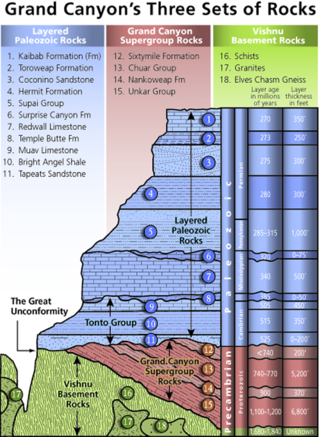
Of the many unconformities (gaps) observed in geological strata, the term Great Unconformity is frequently applied to either the unconformity observed by James Hutton in 1787 at Siccar Point in Scotland, or that observed by John Wesley Powell in the Grand Canyon in 1869. Both instances are exceptional examples of where the contacts between sedimentary strata and either sedimentary or crystalline strata of greatly different ages, origins, and structure represent periods of geologic time sufficiently long to raise great mountains and then erode them away.

Hans Cloos was a prominent German structural geologist.
Marland Pratt Billings was an American structural geologist who was considered one of the greatest authorities on North American geology. Billings was Professor of Geology at Harvard University for almost his entire career, having joined the faculty in 1930 and retired to emeritus status in 1972. He also taught for a brief time at Bryn Mawr College.

The Franciscan Complex or Franciscan Assemblage is a geologic term for a late Mesozoic terrane of heterogeneous rocks found throughout the California Coast Ranges, and particularly on the San Francisco Peninsula. It was named by geologist Andrew Lawson, who also named the San Andreas fault that defines the western extent of the assemblage.

In geology, fissility is the ability or tendency of a rock to split along flat planes of weakness. These planes of weakness are oriented parallel to stratification in sedimentary rocks. Fissility is differentiated from scaly fabric in hand sample by the parting surfaces’ continuously parallel orientations to each other and to stratification. Fissility is distinguished from scaly fabric in thin section by the well-developed orientation of platy minerals such as mica. Fissility is the result of sedimentary or metamorphic processes.

Albert Francis Birch was an American geophysicist. He is considered one of the founders of solid Earth geophysics. He is also known for his part in the atomic bombing of Hiroshima and Nagasaki.
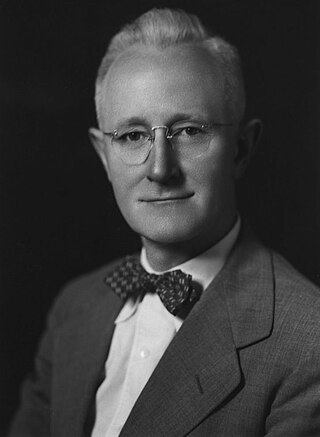
Wilmot Hyde Bradley was an American geologist who served as Chief Geologist of the U.S. Geological Survey from 1944 to 1959, and as President of the Geological Society of America in 1965. He was the tenth Chief Geologist, and his tenure was the longest of any Chief Geologist at the time.
Ragged Staff Cave is a cave bordering the harbour in the British Overseas Territory of Gibraltar. The cave was converted into Ragged Staff Magazine in 1901.
David Samuel Tucker is a geologist, author, and union organizer in Washington state. He is a research associate at Western Washington University. He was an instructor at North Cascades Institute, and the director of the Mount Baker Volcano Research Center. He writes the blog Northwest Geology Field Trips, a blog aimed at laypeople detailing where to find interesting geology in the Pacific Northwest. In 2015, he published a popular book on Washington geology, Geology Underfoot in Western Washington. He resides in Bellingham, Washington. In the 1980s he worked as a mountaineering guide in the Cascades, Mexico, and South America.

Mount Luyendyk is a summit in the western Fosdick Mountains of the Ford Ranges of Marie Byrd Land, West Antarctica. It forms a prominent exposure in the northwestern Iphigene massif. The peak is named in recognition of Bruce P. Luyendyk, professor (emeritus), University of California, Santa Barbara, who was active in ground- and ocean-based Antarctic research from 1989 to 2015, significantly advancing the scientific knowledge of the Ross Embayment region of Antarctica. Luyendyk led two on-land expeditions in the Ford Ranges, and was principal investigator for five marine geophysical expeditions in the Ross Sea.

Geologists Seamounts are a cluster of seamounts in the Pacific Ocean, located mainly 100 miles (160 km) south of Oahu, Hawaii and 100–200 kilometres (62–124 mi) south-west from Big Island (Hawaiʻi). Clockwise from north they are named Perret, Jaggar, McCall, Pensacola, Daly, Swordfish, Cross, Washington and Ellis. The Kauluakalana seamount to the north of Oahu on the far side of the Hawaiian chain to the other seamounts of the cluster, and south-east of the Musicians Seamounts has reason to be regarded as part of the Geologists Seamounts, but would not so be grouped logically by the former name for the cluster.
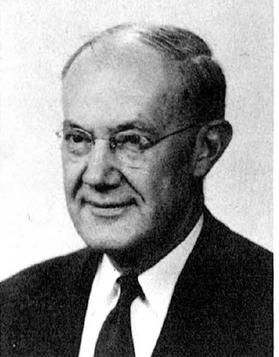
Siemon William Muller was an American paleontologist and geologist, known for his studies on Triassic paleontology and stratigraphy, and for his work on permafrost.
Meers Fault is a fault in Oklahoma that extends from Kiowa County to Comanche County. It is marked by a 22–26 kilometers (14–16 mi) long conspicuous fault scarp but the fault extends beyond the ends of this scarp. The Meers fault is part of a group of faults that lie between the Anadarko Basin and the Wichita Mountains.
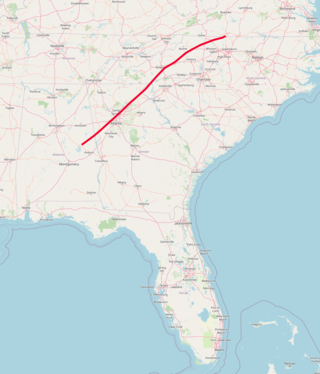
The Brevard Fault Zone is a 700-km long and several km-wide thrust fault that extends from the North Carolina-Virginia border, runs through the north metro Atlanta area, and ends near Montgomery, Alabama. It is an important Paleozoic era feature in the uplift of the Appalachian Mountains.
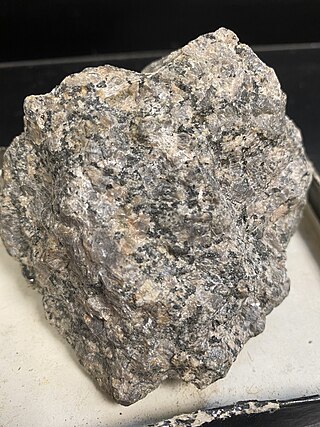
The Concord Gabbro-Syenite Complex is a paleozoic pluton located in North Carolina.

Leopoldo Pilla was an Italian geologist, veterinarian, and physician. He contributed to studies on volcanoes. He died in the Risorgimento while leading a student regiment during the Battle of Curtatone.



















